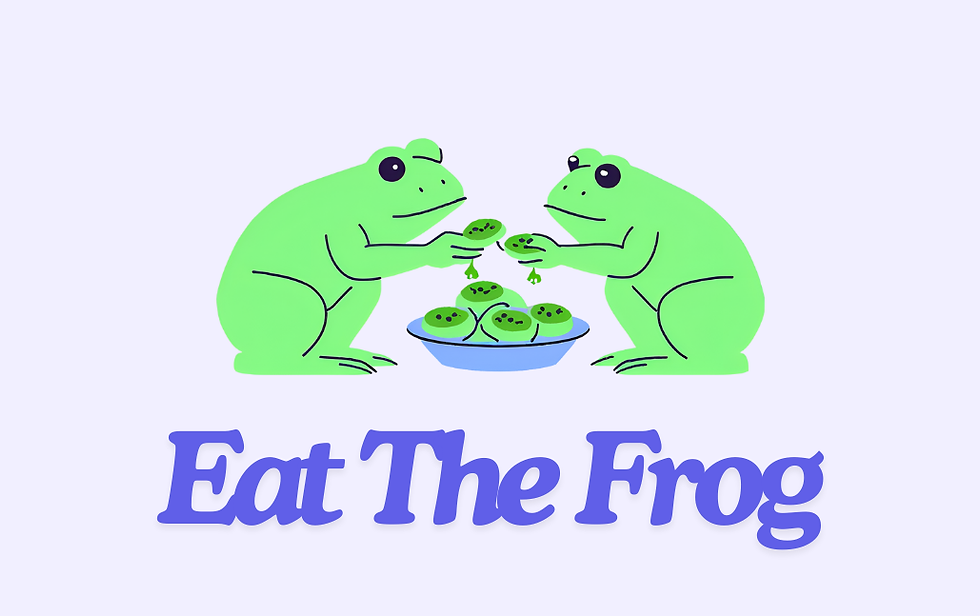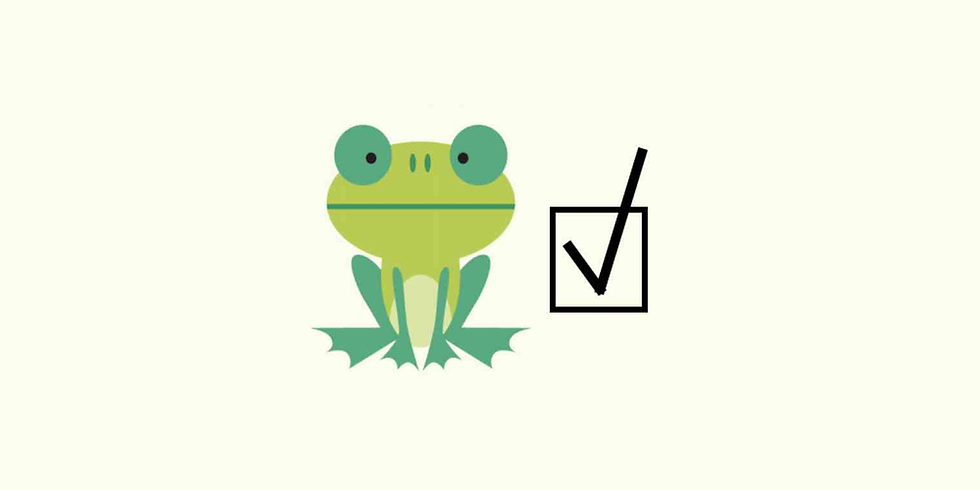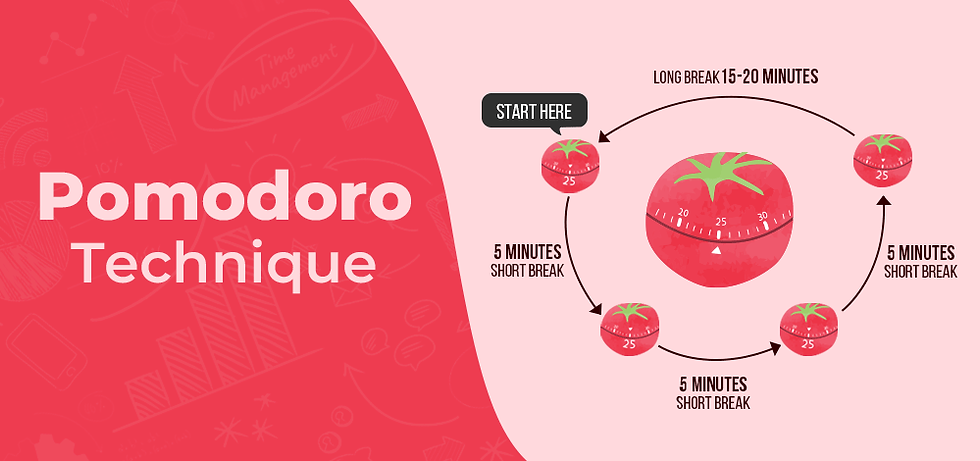Eat That Frog Technique: How This Simple Habit Can Transform Your Productivity Today
- Ethan Carter

- Aug 8
- 10 min read

In today’s fast-paced world, productivity is more than just a buzzword—it’s a vital skill that can empower individuals to achieve their goals efficiently and with less stress. One technique that has gained significant traction among productivity enthusiasts and professionals alike is the Eat That Frog method. Rooted in the wisdom of tackling your most daunting task first, this simple habit promises to revolutionize the way you approach your daily workload.
This comprehensive article will explore the origins, principles, and practical applications of the Eat That Frog productivity technique. You’ll learn how this approach can help you overcome procrastination, prioritize effectively, and build momentum toward sustained success. Throughout, we’ll weave in actionable insights, real-world examples, and research-backed strategies so you can start transforming your productivity habits today.
What Is the Eat That Frog Technique?

The Eat That Frog technique is a productivity strategy popularized by Brian Tracy in his bestselling book Eat That Frog!: 21 Great Ways to Stop Procrastinating and Get More Done in Less Time. The phrase itself is a metaphor derived from a Mark Twain quote:
"If it's your job to eat a frog, it's best to do it first thing in the morning. And if it's your job to eat two frogs, it's best to eat the biggest one first."
In essence, the "frog" represents your most challenging, important, or least appealing task—the one you are most likely to procrastinate on. The core idea is to tackle your hardest or most critical task first thing every day, thereby overcoming procrastination and setting a productive tone for the rest of your day.
Why Focus on Your "Frog" First?
Reduces decision fatigue: By identifying and completing your top priority first, you minimize the mental load of deciding what to work on next.
Builds momentum: Completing a difficult task early instills confidence and energizes you for subsequent tasks.
Prevents procrastination: The biggest tasks often become sources of stress; addressing them immediately alleviates this burden.
Maximizes impact: High-value tasks tend to drive the most significant results in both personal and professional contexts.
According to psychological research, procrastination is linked to anxiety and poor self-regulation (American Psychological Association). By adopting a structured approach like Eat That Frog, you can break the cycle of avoidance and increase task completion rates.
The Psychology Behind Eating Your Frog First
Understanding why the Eat That Frog technique works requires a dive into behavioral psychology and time management science.
Procrastination and Its Cognitive Roots
Procrastination isn’t simply laziness; it's a complex behavior often driven by:
Fear of failure or perfectionism
Overwhelm from task complexity
Lack of clear goals or motivation
Poor time estimation skills
The psychological principle known as temporal discounting explains why people favor immediate, smaller rewards (like checking social media) over bigger, delayed rewards (completing an important report). The Eat That Frog method counters this tendency by forcing immediate action on high-impact tasks.
Practical Example
Consider a freelance graphic designer who delays starting a client’s complex branding project because it feels overwhelming and time-consuming. Instead, they scroll through social media or tidy their workspace—activities that provide instant gratification but little progress. By applying Eat That Frog, the designer commits to working on the branding project first thing in the morning, breaking the task into smaller pieces (e.g., sketching ideas, selecting color palettes), which reduces overwhelm and creates steady progress.
The Zeigarnik Effect: Why Unfinished Tasks Haunt Us
The Zeigarnik effect states that people remember uncompleted or interrupted tasks better than completed ones. This can cause stress and mental clutter when significant tasks linger unfinished. Eating your frog early helps reduce this cognitive load by turning incomplete tasks into completed ones promptly.
Expanded Explanation
This mental tension can manifest as anxiety or distraction throughout the day, pulling your attention away from other activities. For example, an entrepreneur who hasn’t finalized a crucial pitch deck may find their mind wandering back to it during meetings or leisure time. By tackling that pitch deck first, they clear their mental space, improving focus and reducing stress.
Impact on Willpower and Decision Fatigue
Willpower is a finite resource that depletes throughout the day. By eating your frog first, you leverage your peak willpower hours (typically morning for most people), making it easier to confront difficult work without succumbing to distractions.
Deeper Insight
Studies show that decision fatigue impairs self-control and leads to poorer choices as the day progresses. For instance, a manager who delays addressing a complex report until late afternoon may find it difficult to maintain focus or make quality decisions due to depleted willpower. By contrast, tackling this task in the morning ensures it receives optimal cognitive resources.
How to Identify Your “Frog”: Prioritization Strategies

Not every task is a frog. To use this technique effectively, you must identify which task deserves your immediate attention.
Use the Eisenhower Matrix for Task Prioritization
President Dwight D. Eisenhower famously said
"What is important is seldom urgent and what is urgent is seldom important."
The Eisenhower Matrix divides tasks into four quadrants:
Urgent & Important | Important but Not Urgent |
|---|---|
Schedule for later |
Urgent but Not Important | Neither Urgent nor Important |
|---|---|
Delegate | Eliminate |
Your "frog" usually lies in the urgent and important quadrant or sometimes in important but not urgent if procrastinated long enough.
Practical Application
Imagine a project manager who must submit a final project proposal by noon (urgent and important). This is their frog. However, strategic planning for next quarter’s projects might be important but not urgent, so it’s scheduled later. Meanwhile, responding to some non-critical emails may be urgent but not important and can be delegated to an assistant.
This framework helps distinguish between reactive and proactive work, ensuring your energy focuses on tasks that truly move the needle.
The ABCDE Method for Ranking Tasks
Brian Tracy advocates the ABCDE method, where you categorize tasks as follows:
A: Must do (serious consequences if not done)
B: Should do (mild consequences)
C: Nice to do (no consequences)
D: Delegate
E: Eliminate
Start with your A1 task—the biggest frog—and work downwards.
Detailed Example
A1: Fix critical security bug (must do)
A2: Prepare demo for client presentation
B: Review code written by junior developers
C: Organize workspace
D: Delegate documentation updates to a technical writer
E: Remove outdated files
By focusing on A1 first, the developer prevents serious issues and sets a productive tone.
Practical Example: Daily Frog Identification
Prepare urgent client proposal (A1)
Reply to routine emails (C)
Update team project status (B)
Organize files (E)
Your frog here is preparing the client proposal—high-impact and deadline-driven.
Step-by-Step Guide to Implementing Eat That Frog Technique

Adopting any productivity habit requires intentional practice. Here’s how you can incorporate Eat That Frog into your daily routine effectively:
1. Plan Your Day the Night Before
List all tasks.
Identify your frog(s).
Order by priority using ABCDE or Eisenhower methods.
Planning the night before reduces morning decision fatigue and primes your mind for action. For example, a writer who lists tasks and highlights the most challenging chapter to write will find it easier to start work promptly the next day.
2. Start Your Day With Your Frog
Resist all distractions and commit to working on that one task for at least 25 minutes (using techniques like Pomodoro for focus).
Focused time blocks help overcome initial resistance. For example, a sales executive might block 30 minutes to draft a difficult client proposal before checking emails or attending meetings.
3. Break the Task Into Manageable Chunks
Large frogs can feel overwhelming. Break them into smaller steps and start with the easiest subtask to build momentum.
For instance, a student preparing a thesis might break the work into research, outlining, writing sections, and editing. Starting with research creates a sense of progress and reduces anxiety.
4. Eliminate Distractions
Turn off notifications, close irrelevant tabs/apps, and create a focused workspace.
Distraction elimination can include setting phone to “Do Not Disturb,” using noise-cancelling headphones, or working in a quiet room. For example, a software engineer might use apps like Freedom or Cold Turkey to block distracting websites during frog time.
5. Reward Yourself Upon Completion
Positive reinforcement helps build new habits. Treat yourself after finishing your frog to create an association of success.
Rewards can be simple, such as a short walk, a favorite snack, or a brief social media break. For example, after completing a challenging report, a manager might enjoy a coffee break, reinforcing productive behavior.
6. Repeat Daily
Consistency ensures this habit becomes automatic over time.
Over weeks, eating your frog first becomes part of your productivity identity, reducing procrastination triggers and increasing output.
Real-Life Success Stories Using Eat That Frog

Several high-profile individuals and organizations have leveraged this approach to boost productivity:
Example 1: Brian Tracy’s Own Experience
As the creator of the method, Brian Tracy credits Eat That Frog with helping him overcome procrastination during his early career struggles as a sales trainer. By focusing on his toughest tasks first, he increased sales efficiency and career growth dramatically.
He shared that this habit helped him break down overwhelming sales goals into daily priorities, enabling steady progress and confidence.
Example 2: Corporate Adoption at Microsoft
Microsoft employees have incorporated Eat That Frog principles into their workflows by scheduling their “frog” tasks first thing in calendar blocks, reducing multitasking stress and meeting fatigue. This approach aligned well with Microsoft’s productivity guidelines emphasizing deep work (Microsoft WorkLab).
For example, product teams reserve morning hours for focused coding or design sprints, ensuring critical deliverables receive undivided attention.
Example 3: Student Productivity Boost
Students at Cornell University reported a 40% increase in assignment completion rates when applying Eat That Frog combined with effective time-blocking strategies (Cornell University Study).
One student explained that prioritizing the hardest assignments first reduced last-minute cramming and improved overall academic performance.
Example 4: Healthcare Professionals Managing Patient Care
Nurses and doctors often face overwhelming workloads with urgent and complex tasks. By identifying their "frog"—such as completing critical patient assessments first—they improve patient outcomes and reduce errors. Hospitals that train staff in Eat That Frog principles have reported enhanced workflow efficiency during high-pressure shifts.
Common Challenges When Starting Eat That Frog & How to Overcome Them

Even a simple technique can face hurdles in practice. Here are frequent barriers and solutions:
Challenge | Solution |
|---|---|
Difficulty identifying frogs | Use prioritization matrices or apps |
Overwhelm by large tasks | Break tasks into small steps |
Lack of motivation | Integrate rewards and accountability partners |
Interruptions | Set clear boundaries; use "Do Not Disturb" modes |
Fatigue or low energy | Align frogs with peak energy periods |
Detailed Solutions
Difficulty identifying frogs: Many struggle to spot their highest-priority task. Using tools like the Eisenhower Matrix or apps like Todoist with priority flags can clarify your “frog.” Regular reflection and journaling about task impact also help sharpen this skill.
Overwhelm by large tasks: When frogs feel insurmountable, chunking them into smaller, actionable steps can make starting less daunting. For instance, rather than “write report,” break it into “draft introduction,” “gather data,” etc.
Lack of motivation: Motivation fluctuates naturally. Pairing Eat That Frog with accountability partners or productivity groups increases commitment. Setting clear goals and visualizing outcomes can also boost drive.
Interruptions: External demands can derail focus. Communicating your need for uninterrupted time to colleagues or family and using physical cues (closed door, headphones) reinforces boundaries.
Fatigue or low energy: If mornings aren’t your peak time, adjust your frog to align with when you feel most alert. Also, ensure adequate sleep, nutrition, and breaks to sustain energy.
Tip: Consider pairing Eat That Frog with other productivity tools like time tracking or habit stacking for enhanced results.
Tools and Apps to Support Your Eat That Frog Routine

Technology can be a strong ally in maintaining this habit:
Todoist: Prioritize tasks with labels and filters.
Example: Use Todoist’s priority flags to mark frogs as “Priority 1,” ensuring they appear at the top of your list.
remio: Organize and capture your most important tasks and ideas with a flexible note-taking and task management system.
Example: Create a dedicated “Frogs” workspace or tag your highest-priority tasks to keep them front and center, seamlessly integrating notes and action items.
Focus@Will: Music designed to boost concentration.
Example: Play Focus@Will’s scientifically designed soundtracks during frog time to enhance focus.
Forest App: Gamify focus sessions by growing virtual trees as you avoid distractions.
Example: Set a 30-minute focus timer and watch your virtual forest grow as you resist checking your phone.
RescueTime: Analyze time spent on tasks to identify procrastination patterns.
Example: Use RescueTime reports to spot when you typically avoid frogs and adjust your schedule accordingly.
All these tools support prioritizing high-impact tasks first, reinforcing Eat That Frog principles.
Frequently Asked Questions (FAQ)
Q1: What if I have multiple “frogs” in one day?
If multiple critical tasks exist, rank them by impact and urgency. Tackle the largest or most complex frog first, then move sequentially down your priority list.
For example, a project lead might have to finalize a budget and prepare a client presentation. They prioritize the task with the nearest deadline or greatest consequence first, ensuring steady progress on all fronts.
Q2: Can Eat That Frog work for creative or non-linear jobs?
Yes! Creative work benefits from focused blocks on challenging ideas or projects first, freeing mental space for inspiration later.
For instance, an author might dedicate morning hours to drafting difficult chapters, then use afternoons for brainstorming or light editing.
Q3: How long should I spend eating my frog each day?
Focus on completing the entire task if possible; if not, allocate at least 25–50 minutes before switching tasks to ensure meaningful progress.
Using techniques like Pomodoro (25-minute focused intervals) can help maintain intensity without burnout.
Q4: What if I feel burnt out tackling my frog early?
Consider adjusting task complexity or splitting it across days. Also, ensure sufficient rest and energy management strategies are in place.
Taking short breaks, practicing mindfulness, or alternating demanding tasks with lighter ones can prevent burnout.
Q5: How can I maintain this habit long-term?
Consistency and habit stacking are key. Pair eating your frog with an existing routine, like morning coffee or journaling, to anchor the habit. Regularly review and adjust your frogs as priorities evolve.
Conclusion: Why Eating Your Frog Today Is a Game-Changer for Productivity
The Eat That Frog technique offers an elegantly simple yet profoundly effective strategy for overcoming procrastination and boosting productivity by focusing daily efforts on your most challenging but essential tasks first. By understanding the psychology behind procrastination, applying proven prioritization frameworks, and committing to consistent practice, you can transform how you work—and ultimately achieve more with less stress.
Start tonight by identifying tomorrow’s frog and commit to eating it first thing in the morning. This small shift can unleash newfound clarity, focus, and accomplishment across both professional and personal domains.


